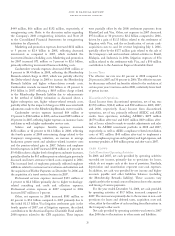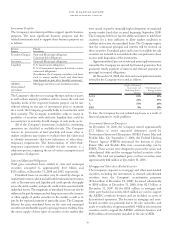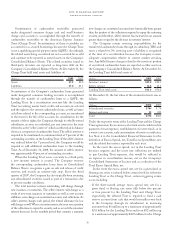American Express 2008 Annual Report Download - page 36
Download and view the complete annual report
Please find page 36 of the 2008 American Express annual report below. You can navigate through the pages in the report by either clicking on the pages listed below, or by using the keyword search tool below to find specific information within the annual report.2008 financial review
american express company
significant amendments to the existing executive compensation
provisions of EESA and adds further restrictions on executive
compensation. Such amendments and additional restrictions are
intended to apply retroactively to the Company and other CPP
participants. The ARRA amends the EESA to, among other
things, limit the amount of bonus or incentive compensation
payable to the Company’s five senior executive officers
identified in the Company’s proxy compensation tables (“senior
executive officers”) and the next 20 most highly compensated
employees (the Top 25) to one-third of the total amount of their
annual compensation and limits the form of such payments to
long-term restricted stock that does not fully vest during the
period in which the Series A Preferred Stock is outstanding.
Additionally, the ARRA expands the clawback provisions and
golden parachute restrictions of EESA, which are described
above, by applying them not only to senior executive officers,
but also to the next 20 most highly compensated employees in
the case of clawbacks and next five most highly compensated
employees in the case of golden parachutes. The ARRA also
contains a provision that requires the Treasury Department
to review bonuses and incentive compensation previously
paid to the Top 25 to determine whether any such payments
were inconsistent with the purpose of the ARRA or otherwise
contrary to the public interest, and if so determined, to negotiate
for appropriate reimbursements.
As of January 9, 2009, both the Series A Preferred Stock
and Warrant are accounted for as permanent equity on the
Company’s Consolidated Balance Sheet, based on a relative fair
value allocation, and components of capital, thus enhancing the
Company’s Tier 1 and Total Capital ratios. The issuance of the
Series A Preferred Stock and Warrant is expected to reduce the
Company’s Net Income Available to Common Shareholders in
determining basic and diluted EPS.
The amount of the Treasury Department’s investment in
American Express was determined by a formula based on the
asset size of the Company. The additional capital from the CPP
gives the Company added stability and capital strength to pursue
its business objectives. This investment allows the Company to
continue to make credit available to customers—whether they
are retail consumers, small businesses, or corporations.
share repurchases and dividends
The Company has a share repurchase program to return equity
capital in excess of regulatory and rating agency requirements,
internal risk-based evaluation, and business needs to
shareholders. These share repurchases both offset the issuance
of new shares as part of employee compensation plans and
reduce shares outstanding.
Approximately 68 percent of capital generated has been
returned to shareholders since inception of the share repurchase
program in 1994. The Company reduced its level of share
repurchases in the first quarter of 2008 from previous levels in
order to use the funds generated from operations to acquire the
CPS business from GE. During 2008, the Company purchased
4.7 million common shares at an average price of $46.10. No shares
have been repurchased since the first quarter of 2008 in light of
the economic uncertainties and concerns about a global recession
and in order to use the funds generated from operations to acquire
the CPS business from GE. Under the terms of the CPP, the
Company is not permitted to repurchase shares of its common
stock other than to offset issuances under benefit plans consistent
with past practices and in certain other limited circumstances.
Additionally, the Company will not be permitted to increase
its dividend to common shareholders under the CPP. The
Company may also be required to cut or eliminate such dividend
under regulatory guidelines if earnings are not sufficient to cover
the payouts. Also, the Company must satisfy all dividends on
the Series A Preferred Stock before any dividends can be paid to
common shareholders. For certain contractual restrictions related
to payment of the Company’s dividend, see further discussion in
Note 10 to the Consolidated Financial Statements.
funding strategy
The Company seeks to maintain broad and well-diversified
funding sources to allow it to meet its maturing obligations
and cost-effectively finance current and future asset growth in
its global businesses as well as to maintain a strong liquidity
profile. Diversity of funding sources by type of debt instrument,
by maturity and by investor base, among other factors, provides
additional insulation from the impact of disruptions in any one
type of debt, maturity, or investor. The mix of the Company’s
funding in any period will seek to achieve cost-efficiency consistent
with both maintaining diversified sources and achieving its
liquidity objectives. The Company’s funding strategy and activities
are integrated into its asset-liability management activities.
The Company’s proprietary card businesses are the
primary asset-generating businesses, with significant assets in
both domestic and international cardmember receivable and
lending activities. The Company’s borrowing needs are in large
part associated with its proprietary card businesses and the
maintenance of a liquidity position to support all of its business
activities, such as merchant payments. The Company generally
pays merchants for card transactions prior to reimbursement by
cardmembers. The Company funds merchant payments during
the period cardmember loans and receivables are outstanding.
The Company also has additional borrowing needs associated
with general corporate purposes. The Company seeks to
establish and maintain access to a broad and diversified set of
funding sources.
The recent turmoil in the money and capital markets during
2008 resulted in changes to the mix and cost of financing the
Company obtained from its traditional funding sources, as well
as the establishment and expansion of its retail deposit-taking
activities.
34
























